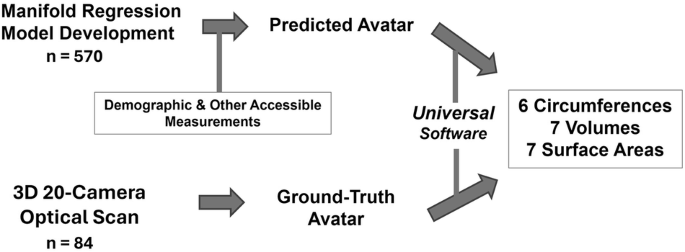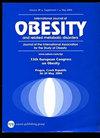Accurate prediction of three-dimensional humanoid avatars for anthropometric modeling
IF 4.2
2区 医学
Q1 ENDOCRINOLOGY & METABOLISM
引用次数: 0
Abstract
To evaluate the hypothesis that anthropometric dimensions derived from a person’s manifold-regression predicted three-dimensional (3D) humanoid avatar are accurate when compared to their actual circumference, volume, and surface area measurements acquired with a ground-truth 3D optical imaging method. Avatars predicted using this approach, if accurate with respect to anthropometric dimensions, can serve multiple purposes including patient body composition analysis and metabolic disease risk stratification in clinical settings. Manifold regression 3D avatar prediction equations were developed on a sample of 570 adults who completed 3D optical scans, dual-energy X-ray absorptiometry (DXA), and bioimpedance analysis (BIA) evaluations. A new prospective sample of 84 adults had ground-truth measurements of 6 body circumferences, 7 volumes, and 7 surface areas with a 20-camera 3D reference scanner. 3D humanoid avatars were generated on these participants with manifold regression including age, weight, height, DXA %fat, and BIA impedances as potential predictor variables. Ground-truth and predicted avatar anthropometric dimensions were quantified with the same software. Following exploratory studies, one manifold prediction model was moved forward for presentation that included age, weight, height, and %fat as covariates. Predicted and ground-truth avatars had similar visual appearances; correlations between predicted and ground-truth anthropometric estimates were all high (R2s, 0.75–0.99; all p < 0.001) with non-significant mean differences except for arm circumferences (%Δ ~ 5%; p < 0.05). Concordance correlation coefficients ranged from 0.80–0.99 and small but significant bias (p < 0.05–0.01) was present with Bland-Altman plots in 13 of 20 total anthropometric measurements. The mean waist to hip circumference ratio predicted by manifold regression was non-significantly different from ground-truth scanner measurements. 3D avatars predicted from demographic, physical, and other accessible characteristics can produce body representations with accurate anthropometric dimensions without a 3D scanner. Combining manifold regression algorithms into established body composition methods such as DXA, BIA, and other accessible methods provides new research and clinical opportunities.


为人体测量建模准确预测三维仿人头像。
目的评估一个假设,即从一个人的流形回归预测的三维(3D)仿人头像得出的人体测量尺寸,与通过地面真实三维光学成像方法获得的实际周长、体积和表面积测量值相比,是否准确。使用这种方法预测的头像,如果在人体测量尺寸方面准确无误,则可用于多种用途,包括临床环境中的病人身体成分分析和代谢疾病风险分层:方法:对完成三维光学扫描、双能 X 射线吸收测量(DXA)和生物阻抗分析(BIA)评估的 570 名成人样本进行了多重回归三维头像预测方程的开发。一个由 84 名成年人组成的新的前瞻性样本使用 20 个摄像头的三维参考扫描仪对 6 个体围、7 个体积和 7 个表面积进行了地面实况测量。在这些参与者身上生成了三维仿人头像,并将年龄、体重、身高、DXA 脂肪率和 BIA 阻抗等多方面回归作为潜在的预测变量。使用同一软件对地面实况和预测的头像人体测量尺寸进行量化:结果:经过探索性研究,我们提出了一个多方面预测模型,其中包括年龄、体重、身高和脂肪率。预测的头像与地面实况头像具有相似的视觉外观;预测的人体测量值与地面实况人体测量值之间的相关性都很高(R2,0.75-0.99;均为 p):根据人口、身体和其他可获取特征预测的三维头像可以在没有三维扫描仪的情况下生成具有准确人体测量尺寸的身体表征。将流形回归算法与 DXA、BIA 等成熟的身体成分测量方法及其他可获得的方法相结合,可提供新的研究和临床机会。
本文章由计算机程序翻译,如有差异,请以英文原文为准。
求助全文
约1分钟内获得全文
求助全文
来源期刊

International Journal of Obesity
医学-内分泌学与代谢
CiteScore
10.00
自引率
2.00%
发文量
221
审稿时长
3 months
期刊介绍:
The International Journal of Obesity is a multi-disciplinary forum for research describing basic, clinical and applied studies in biochemistry, physiology, genetics and nutrition, molecular, metabolic, psychological and epidemiological aspects of obesity and related disorders.
We publish a range of content types including original research articles, technical reports, reviews, correspondence and brief communications that elaborate on significant advances in the field and cover topical issues.
 求助内容:
求助内容: 应助结果提醒方式:
应助结果提醒方式:


